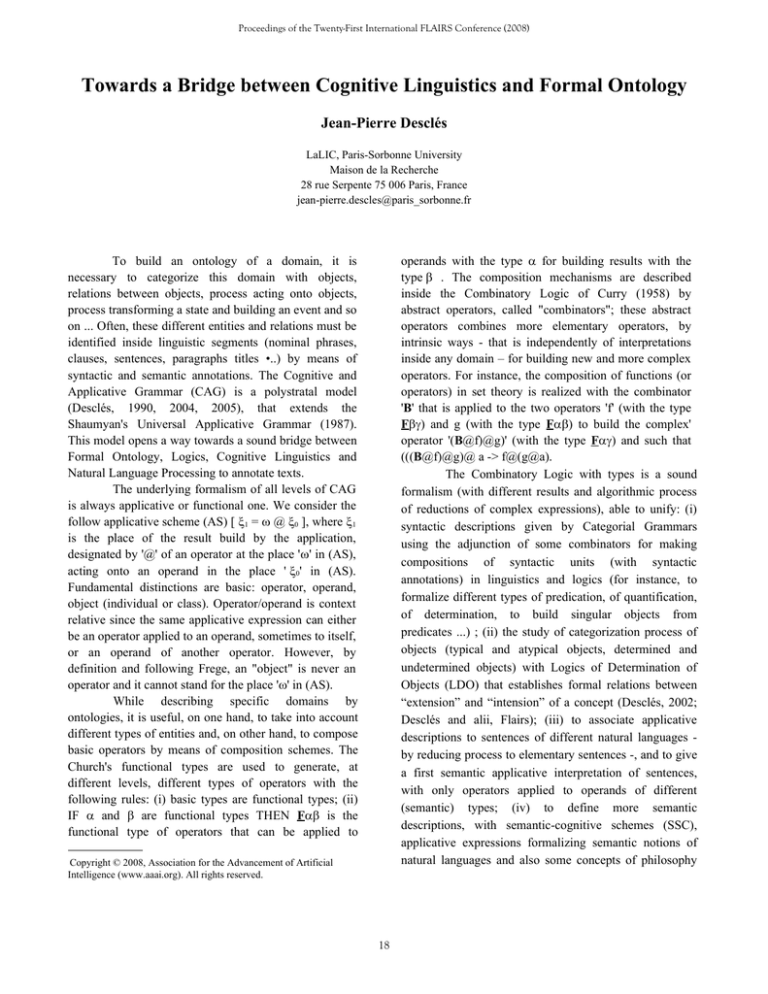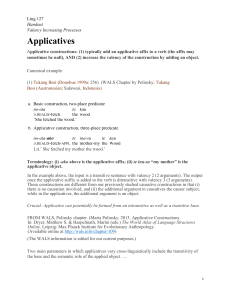
Proceedings of the Twenty-First International FLAIRS Conference (2008)
Towards a Bridge between Cognitive Linguistics and Formal Ontology
Jean-Pierre Desclés
LaLIC, Paris-Sorbonne University
Maison de la Recherche
28 rue Serpente 75 006 Paris, France
jean-pierre.descles@paris_sorbonne.fr
operands with the type α for building results with the
type β . The composition mechanisms are described
inside the Combinatory Logic of Curry (1958) by
abstract operators, called "combinators"; these abstract
operators combines more elementary operators, by
intrinsic ways - that is independently of interpretations
inside any domain – for building new and more complex
operators. For instance, the composition of functions (or
operators) in set theory is realized with the combinator
'B' that is applied to the two operators 'f' (with the type
Fβγ) and g (with the type Fαβ) to build the complex'
operator '(B@f)@g)' (with the type Fαγ) and such that
(((B@f)@g)@ a -> f@(g@a).
The Combinatory Logic with types is a sound
formalism (with different results and algorithmic process
of reductions of complex expressions), able to unify: (i)
syntactic descriptions given by Categorial Grammars
using the adjunction of some combinators for making
compositions of syntactic units (with syntactic
annotations) in linguistics and logics (for instance, to
formalize different types of predication, of quantification,
of determination, to build singular objects from
predicates ...) ; (ii) the study of categorization process of
objects (typical and atypical objects, determined and
undetermined objects) with Logics of Determination of
Objects (LDO) that establishes formal relations between
“extension” and “intension” of a concept (Desclés, 2002;
Desclés and alii, Flairs); (iii) to associate applicative
descriptions to sentences of different natural languages by reducing process to elementary sentences -, and to give
a first semantic applicative interpretation of sentences,
with only operators applied to operands of different
(semantic) types; (iv) to define more semantic
descriptions, with semantic-cognitive schemes (SSC),
applicative expressions formalizing semantic notions of
natural languages and also some concepts of philosophy
To build an ontology of a domain, it is
necessary to categorize this domain with objects,
relations between objects, process acting onto objects,
process transforming a state and building an event and so
on ... Often, these different entities and relations must be
identified inside linguistic segments (nominal phrases,
clauses, sentences, paragraphs titles •..) by means of
syntactic and semantic annotations. The Cognitive and
Applicative Grammar (CAG) is a polystratal model
(Desclés, 1990, 2004, 2005), that extends the
Shaumyan's Universal Applicative Grammar (1987).
This model opens a way towards a sound bridge between
Formal Ontology, Logics, Cognitive Linguistics and
Natural Language Processing to annotate texts.
The underlying formalism of all levels of CAG
is always applicative or functional one. We consider the
follow applicative scheme (AS) [ ξ1 = ω @ ξ0 ], where ξ1
is the place of the result build by the application,
designated by '@' of an operator at the place 'ω' in (AS),
acting onto an operand in the place ' ξ0' in (AS).
Fundamental distinctions are basic: operator, operand,
object (individual or class). Operator/operand is context
relative since the same applicative expression can either
be an operator applied to an operand, sometimes to itself,
or an operand of another operator. However, by
definition and following Frege, an "object" is never an
operator and it cannot stand for the place 'ω' in (AS).
While describing specific domains by
ontologies, it is useful, on one hand, to take into account
different types of entities and, on other hand, to compose
basic operators by means of composition schemes. The
Church's functional types are used to generate, at
different levels, different types of operators with the
following rules: (i) basic types are functional types; (ii)
IF α and β are functional types THEN Fαβ is the
functional type of operators that can be applied to
Copyright © 2008, Association for the Advancement of Artificial
Intelligence (www.aaai.org). All rights reserved.
18
(for instance the phenomenology) used in Formal
Ontology.
CAG is a logical and linguistic model with three
levels of applicative representations, where each level is
formally articulated with the other. In a bottom up
presentation, we describe these levels as follows: (i) the
first level contains the syntactical and morphological
configurations of sentences and texts; Extended Categorial
Grammars, seen as Grammars of operators (whose
functional types represent syntactic categories) are formal
devices used to annotate sentences in a text; (ii) from the
results obtained on the first level, the second level
expresses the applicative decompositions into operators
and operands of sentences and texts; the calculus of
reduced expressions (whose the unicity follows from the
Church-Rosser' s theorem) leads towards semantic
interpretations of grammatical operators (abstract cases Agent, Localizer, Instrument, Experiencer . . . - , tenses
and aspects, modalities, voices, ...) (Desclés, 1990, 2005);
(iii) At the third level, the semantic representations of the
meanings of lexical predicates and lexical operators are
built from the lower level, in terms of "change",
"movement", "control of change or movement by an
agent", "intentional teleonomy which aim is fixed",
"locating an object inside a locus", "topological
determinations of loci (temporal, spatial, abstract loci)".
In general, each unit (a definiendum) from any
level is decomposed into a complex of more elementary
units (its definiens) of an upper level, the relation between
definiendum and definiens being described by a
combinator (an operator for a semantic composition). By
using Curry’s Combinatory Logic (a logic without bound
variables), and not the Church’s λ-calculus, deductions are
easer and more explicit, from a computing viewpoint,
since we do not have to manage the changes of names of
bound variables during a deduction process (Desclés,
2004, 2005)
The model of CAG, essentially with the third
level, is an useful tool to define and to formalize the
general representations in the semantic of natural
languages, by means of cognitive and formal
conceptualizations, more complex than the descriptions
with only boolean features. It permits to give different
(syntactic and semantic) annotations in texts in a
Web-semantic perspective, in complement of the EXCOM
methodology (Desclés and alii, Flairs) with "semantic
maps" (for a processing of discursive categories). The talk
will present the general concepts of CAG and its cognitive
and computational architecture, the applicative underlying
formalism with the help of some illustrative examples.
References
Curry H.B., Feys, R., Combinatory Logic, North
Holland, 1958.
Desclés, J.-P., Langages applicatfs, langues naturelles et
cognition, Paris : Hermès, 1990.
Desclés, J.-P., « Categorization: A Logical Approach to a
Cognitive Problem", Journal of Cognitive Sciences, Vol. 3,
N° 2, 2002, pp. 85-137.
Desclés, J.-P., "Combinatory Logic, Language, and
Cognitive Representations, in P. Weingartner (editor),
Alternative Logics. Do Sciences Need Them ?, Springer,
2004, pp. 115148.
Desclés, J.-P., "Reasoning and Aspectual-temporal
Calculus", in D. Wanderveken, Logic,
Thought and Action, Springer, 2005, pp. 217-244.
Desclés, J.-P., and ali, Presentations in
Flairs 04, Flairs 05, Flairs 06, Flairs 07.
Shaumyan, S.K., A Semiotic Theory of Language,
Bloomington: Indiana University Press, 1987.
19


